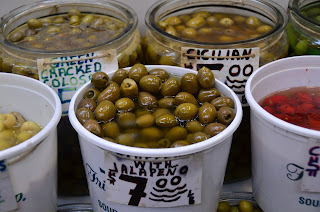When we'd have some kainan at school, my Spanish students would always bring tortilla and it would always be good. I asked them how to make one but one's description would be different from another's. Like our adobo, or the Korean kimchi, each cook's version is the best, the definitive, the authentic one. And like these other dishes, there is a basic technique from which one can riff. Finally, one of my Spanish students, who lived in an apartment with a nice kitchen, graciously showed me how it's done, step-by-step. And one night, I made one myself. I posted a picture of the finished product on my Facebook page and it generated a good number of likes and inquiries on how I did it. The dish is simple, and so is its preparation. (The only tricky part is flipping the uncooked half tortilla on to the pan). Here's my version of Juanra's Tortilla de Patata:
7 large eggs (at room temperature)
3/4 lb. potatoes, peeled and sliced (use the 2 mm blade when using a food processor or mandoline)
(An option is to use 3/4 of the usual quantity of potato and 1/4 of white or yellow or Spanish onion)
1 cup olive oil
salt and pepper to taste

I cooked my tortilla in one of my cooking essentials, the cast iron pan. A good kitchen should have one: it is inexpensive, versatile, and will live longer than Methuselah.
 Fill the pan with the olive oil. Essentially, what you are doing is boiling, yes boiling, the potato in olive oil, not frying them, so make sure you don't fill up your pan with the sliced potato and that you don't brown them. If your pan is too small, boil the potatoes in batches, about 10 minutes. Season, then continue to cook them until they are fork tender. Set aside. If you are using onions, cook them separately from the potatoes for about 10 minutes.
Fill the pan with the olive oil. Essentially, what you are doing is boiling, yes boiling, the potato in olive oil, not frying them, so make sure you don't fill up your pan with the sliced potato and that you don't brown them. If your pan is too small, boil the potatoes in batches, about 10 minutes. Season, then continue to cook them until they are fork tender. Set aside. If you are using onions, cook them separately from the potatoes for about 10 minutes.Pour off the oil and save any excess for future use (you can reuse olive oil up to three times. It's best to separate leftover oil for each type of food cooked in it). Rub the pan clean with a paper towel.
 |
| This is not the way to cook the potatoes. There should only be one layer cooking in the pan at a time. |
 |
| Incorporating the cooked potatoes into the beaten eggs |
And there you have it: quick, simple, easy, filling and inexpensive. Spanish bars cut up cold tortilla into cubes to serve as tapas with mayonnaise on the side (God forbid you should suggest ketchup to a Spaniard). Serve with a green salad and bread for a meal. Snack on leftovers. It is also a very versatile dish. You can add chorizo, ham, flaked cooked fish, chopped asparagus, etc.
 |
| The top uncooked half of the tortilla |
And there you have the tortilla de patata.
 |
| The finished product. |
Bon appetit!



